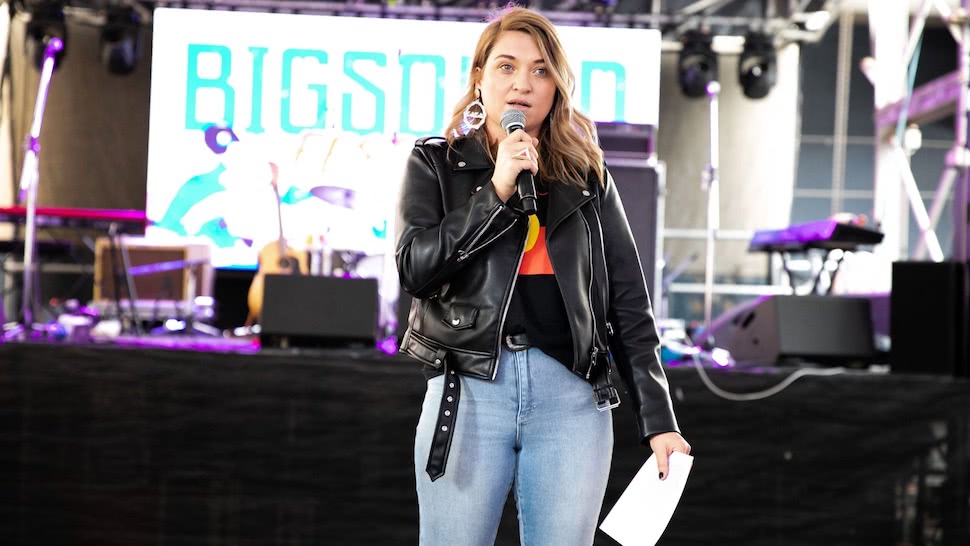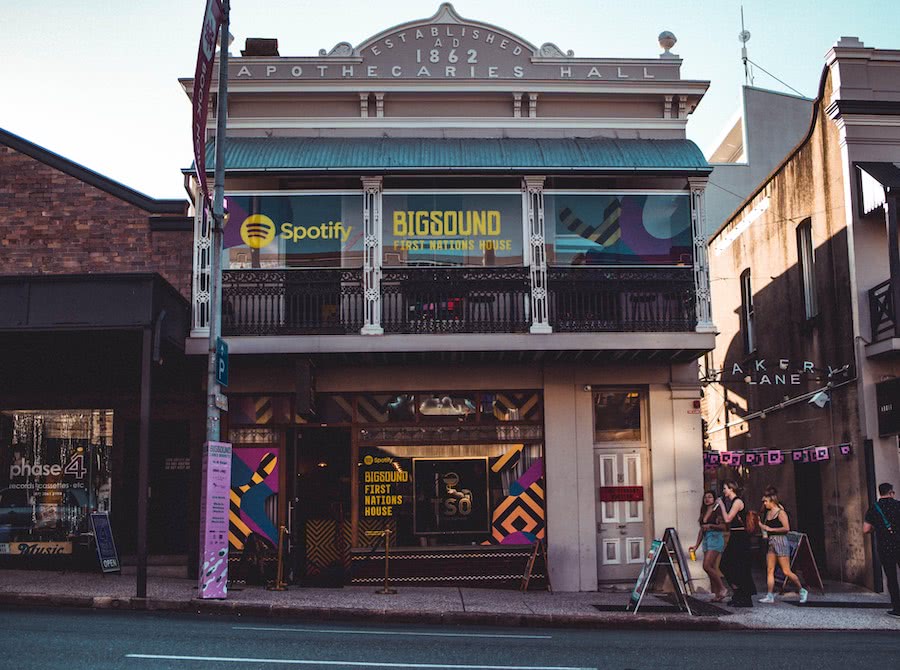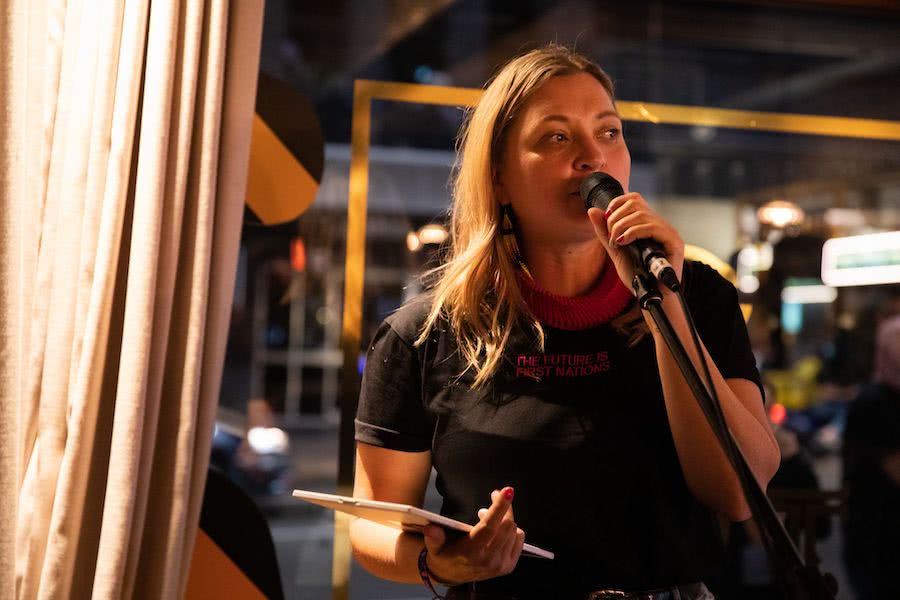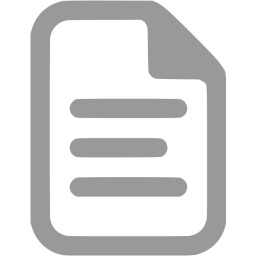Spotlight: At work with Alethea Beetson, Artistic Director of Digi Youth Arts + QMusic First Nations Programmer

Alethea Beetson works from a place of integrity. Her career simultaneously offers a much needed contribution to the arts and the music industry, while it also works to dismantle systems specifically designed to work against First Nations peoples.
A Kabi Kabi + Wiradjuri artist and producer, Alethea Beetson is the Artistic Director of Digi Youth Arts, and QMusic’s First Nations Programmer. Based in Brisbane, she runs a number of projects, and was the curator of last year’s First Nation programme at BIGSOUND, a conference and live festival highlight.
So-called Australia and its music industry has much work to do in order to pay the rent and give space to its First Nations peoples. And while the Black Lives Matter movement continues, Alethea Beetson is one voice helping to shape the much-needed narrative, offering a critical perspective for anyone living on this land.
Tell us about Digi Youth Arts, what are you working on at the moment?
Digi Youth Arts is an Indigenous youth arts organisation committed to sharing the stories of our young people. We are based in so-called Queensland and are slowly starting to work with communities outside of this colonial State. At the moment my focus is on mentoring Emily Coleman as she takes on more responsibility as Acting Associate Artistic Director of the organisation.
Emily, alongside Merryn Trescott and Loki Liddle will be producing a number of projects with young people over the next six months. The Ancient Bloods (DYA’s interchanging band) are set to release a new album later this year.
We begin working on a new podcast called Original Influencers in August which sees young people use digital and social media platforms that weren’t available to our elders to honour them and share their stories. We will also be turning one of the plays I wrote and directed with and for young people into a short film.
So lot’s of exciting projects but more importantly, lots of Indigenous young people working in the arts and telling our mob’s stories.
What motivates you?
The many different, non-homogenous stories of my community, and that includes my Indigenous relatives across the oceans. Whether it is working with young people, or learning from elders or programming music, I am drawn to the work for the stories, and the deep meaning that this has for me culturally.
In many ways I am lucky that I get to live and fight for something that is so much bigger than myself. It keeps ego in check, and then motivates you to work from a place of integrity.
You’ve done a lot of work with festivals, events and conferences over the years. What have you learned about the impact of Indigenous programs?
The work I get to do now comes off the back of the often-silenced work of Aunties and Uncles who have gone before me. As someone carrying on from the work of others, I have learnt the importance of continuing to carve out space for Indigenous artists and community leaders as much as possible. And that it takes all of us mob working in these spaces to continue to dismantle the systems that were designed to work against us.
The part of the work that connects me with my community through story brings me great joy, but that is not always the reality of Indigenous programming.
I have has also learnt that not everyone is willing to check their privilege. Not everyone wants the system dismantled. Not everyone wants to move aside to allow for change.
I often wonder if beside every substantive Indigenous program is a series of really difficult conversations that no one got to see where some non-Indigenous folk handled it well, and others didn’t.
The work you did with BIGSOUND last year curating a First Nations program was really impressive. How do you feel about that program now looking back?
BIGSOUND 2019 saw the largest cohort of Aboriginal and/or Torres Strait Islander artists showcasing at the festival. And also included more programming and initiatives such as the BIGSOUND First Nations House presented by Spotify.

The BIGSOUND First Nations House
As part of the commitment to providing spaces for the global Indigenous music network, BIGSOUND partnered with Manitoba Music to present the Indigenous North Showcase with three First Nations artists from Turtle Island/Canada. The connection with our brothers and sisters across the oceans were really some of the most special parts of the festival.
Each of the conversations curated in the conference program came from community engagement at the previous festival and throughout the year. Based on attendee and wider industry feedback, the Indigenous music community were glad that progress in this space was made.
In looking back though, I wonder if the time had come and it was really just what was very much needed.
Would you change anything for the next BIGSOUND instalment?
Like all of my work, I would hope that the event takes the next steps forward in this space. We have to continue on from progress made, to create more change.
More and more space needs to be carved out for Indigenous musicians and sovereign led conversations. Not just at BIGSOUND but in every part of the music industry.
From your career working in the arts, specifically your experience working in and with the music industry, what have you learned about how the local music sector handles First Nations culture?
A year ago I might have answered this question very differently and perhaps more favourably to the music industry. I have worked across most art forms in programming roles, and I think the music industry has an incredibly long way to go in terms of engaging with First Nations art and culture.
During the COVID19 pandemic it felt like a lot of the progress we had made was very quickly lost. I saw online festival programming not include any Indigenous artists, conversations that did not allow for mob’s voices, and more recently the industry’s response to returning to live music has largely not included First Nations musicians.
I think there are really great examples of where the music industry has done some of the work, but there needs to be so much more. The music industry were the first to get behind the trending part of #blacklivesmatter movement without necessarily doing any of the learning, unlearning and space giving.
A week after most of the music industry shared a black tile in support of the Black Lives Matter movement both here and overseas, everyone went back to sharing line-ups of mostly white artists. The lack of real reflection was incredibly visible.

Alethea Beetson. Photo Credit: LaVonne Bobongie
How can the music industry better unite with First Nations peoples?
Pay the rent. Give space. Hand over the keys. And importantly listen to Indigenous musicians, and what they are asking for (and have been asking for).
That is where I have learnt how to do my job and serve the artists I am here to work for: by listening to them and believing them. It really isn’t that hard.
What impact are you hoping the current Black Lives Matter movement has on Australia’s music and arts industries?
As mentioned before, I would like to see some real reflection, actual learning and tangible action. No more sharing content on social media without also doing the real work inside yourself and your organisation to dismantle the oppressive structures that underpin the music industry.
No more only following people on social media without actually connecting with the Indigenous people in your local community and music spaces. No more only paying attention because it was a trend without making a life-long commitment to do the work.
If you could share just three links for people in the music industry who want to further educate themselves on Australia’s Blak history, which would you choose?
I don’t think I could really narrow it down, but I will share three resources that I have been engaging with lately:
The White Possessive by Aileen Moreton-Robinson – this book is extremely relevant to critical race theory in so-called Australia and a must read.
Uncle Kev Carmody’s entire discography – I just love the breadth of stories across his work and I think that breadth of experience is important to remember as people learn more about Blak history.
Float Little Boat Float by Jhindu Lawrie – Part of the learning must include joy in all forms, and for me this children’s song which also celebrates language, is just that.
Finally, what albums or artists do you have on repeat at the moment?
The Merindas album We Sing Until Sunrise
Miiesha’s album Nyaaringu
River Boy’s track ‘Gimme My Soul’
Crown Lands’ EP/album Rise Over Run
Check out Crown Lands’ Rise Over Run:
:: A beginner’s guide to supporting First Nations peoples & being anti-racist
This article originally appeared on The Industry Observer, which is now part of The Music Network.

































